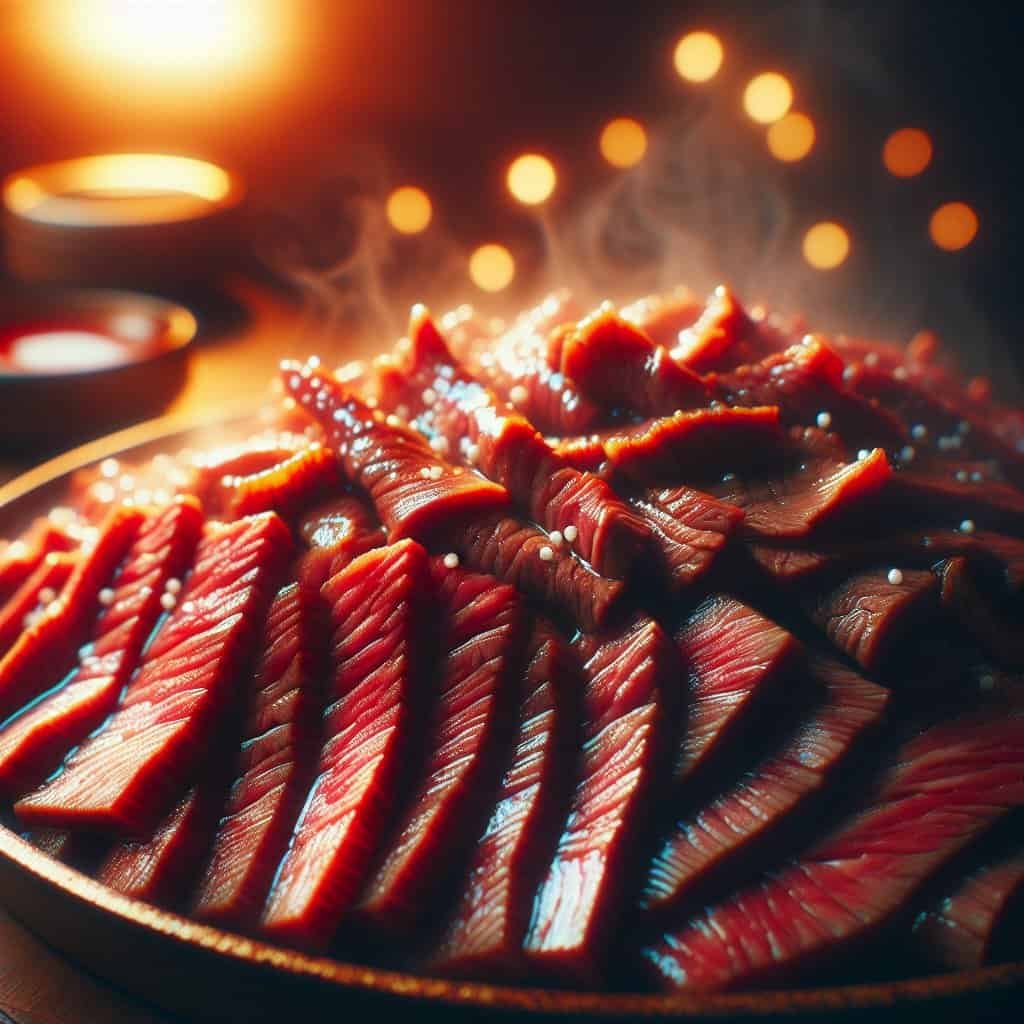If you’re a fan of beef dishes, you may already be familiar with the succulent and flavorful dish known as bulgogi. But have you ever wondered what sets this traditional Korean dish apart from other beef preparations? The secret lies in the unique marinade and cooking method used when preparing bulgogi. Unlike other beef dishes, bulgogi is marinated for hours in a mixture of soy sauce, sesame oil, sugar, garlic, and other seasonings, allowing the flavors to penetrate and tenderize the meat. This slow marinating process results in a dish that is incredibly tender, juicy, and bursting with savory flavors. Let’s explore the nuances of this beloved Korean dish and discover what makes bulgogi truly stand out among other beef dishes.

Preparation of Traditional Bulgogi
Traditional bulgogi is a delicious Korean dish made with thinly sliced beef that is marinated in a flavorful sauce, then grilled or pan-fried to perfection. The preparation of traditional bulgogi sets it apart from other beef dishes, resulting in a unique and mouthwatering flavor.
Ingredients
To make traditional bulgogi, you will need the following ingredients:
Beef: The star of the dish, thinly sliced beef is the key component of bulgogi. You can use various cuts of beef, such as sirloin, tenderloin, or ribeye, depending on your preference.
Soy Sauce: Soy sauce adds a rich umami flavor to the marinade, enhancing the overall taste of the dish.
Sugar: A touch of sweetness from sugar balances out the savory flavors in the marinade and helps in caramelization during cooking.
Pear: Pear is a secret ingredient in bulgogi marinade that adds natural sweetness and also helps tenderize the meat due to its enzymes.
Garlic: Freshly minced garlic adds a savory and aromatic dimension to the marinade.
Sesame Oil: Toasted sesame oil contributes a nutty and rich flavor to the marinade, enhancing the overall taste profile of the dish.
Black Pepper: Black pepper adds a subtle kick of heat and depth of flavor to the marinade.
Sesame Seeds: Toasted sesame seeds are sprinkled on top of the cooked bulgogi for an extra layer of nuttiness and texture.
Marinade
The marinade is what gives bulgogi its distinct flavor. It is a combination of soy sauce, sugar, pear, garlic, sesame oil, black pepper, and sesame seeds. The traditional marinade recipe is a well-balanced blend of sweet and savory flavors, resulting in a mouthwatering taste.
Traditional Marinade Recipe
To make the traditional bulgogi marinade, combine the following ingredients in a bowl or a blender:
- 1/2 cup soy sauce
- 2 tablespoons sugar
- 1/2 pear, grated
- 4 cloves of garlic, minced
- 1 tablespoon sesame oil
- 1/2 teaspoon black pepper
- 1 tablespoon sesame seeds
Mix all the ingredients until the sugar is dissolved and the marinade is well combined. The pear should provide a natural sweetness to balance out the savory flavors of the soy sauce and garlic.
Marinating Time
For the best flavor and tenderness, it is recommended to marinate the beef for at least 2 hours to overnight. This allows the meat to absorb the flavors of the marinade and become more tender. The longer the marinating time, the more flavorful the bulgogi will be.
Preparation
Preparing traditional bulgogi involves slicing the beef, preparing the marinade, and marinating the beef before cooking.
Slicing the Beef
To achieve thin and even slices of beef, it is best to partially freeze the meat for about 30 minutes to an hour before slicing. This makes it easier to handle and ensures consistent thickness. Using a sharp knife, slice the beef against the grain into thin strips. The slices should be about 1/8 to 1/4 inch thick.
Preparing the Marinade
Follow the traditional marinade recipe provided earlier to prepare the bulgogi marinade. Combine all the marinade ingredients in a bowl or blender and mix until well combined. Adjust the sweetness or saltiness according to your taste preference.
Marinating the Beef
Place the sliced beef into a shallow dish or a resealable plastic bag. Pour the marinade over the beef, making sure every slice is coated evenly. Massage the marinade into the meat to ensure it is well absorbed. Cover or seal the dish or bag and refrigerate for at least 2 hours, preferably overnight, to allow the flavors to penetrate the beef.
Cooking
After marinating the beef, it’s time to cook the bulgogi. There are two popular cooking methods: grilling and pan-frying.
Grilling
Grilling is a traditional way of cooking bulgogi, giving it a smoky and charred flavor. You can use a charcoal grill or a gas grill, depending on the equipment you have available.
Charcoal Grill
To grill bulgogi on a charcoal grill, preheat the grill to medium-high heat. Drain the marinade from the beef slices and place them directly on the grill grates. Cook for approximately 2-3 minutes per side, or until the beef is cooked to your desired doneness. The high heat will help create a nice char on the surface of the meat.
Gas Grill
To grill bulgogi on a gas grill, preheat the grill to medium-high heat. Drain the marinade from the beef slices and place them on a grill pan or a piece of foil to prevent them from falling through the grates. Cook for approximately 2-3 minutes per side, or until the beef is cooked to your liking.
Alternative Methods
If you don’t have access to a grill, you can still enjoy delicious bulgogi by using alternative cooking methods such as broiling in the oven or using a stovetop grill pan. Adjust the cooking time accordingly to ensure the beef is cooked through.
Pan-Frying
Pan-frying is another popular method of cooking bulgogi, especially if you don’t have access to a grill. It allows for a quick and convenient way to enjoy this flavorful dish.
Cooking Oil
To pan-fry bulgogi, heat a small amount of cooking oil, such as vegetable or canola oil, in a large frying pan or skillet over medium-high heat. The oil helps prevent the beef from sticking to the pan and provides a flavorful sear.
Medium-High Heat
Once the oil is hot, add the marinated beef slices to the pan, making sure not to overcrowd the pan. Cook for approximately 2-3 minutes per side, or until the beef is cooked to your liking. The high heat helps achieve a caramelized and slightly crispy exterior while keeping the inside juicy and tender.
Frying Pan
If you don’t have a large enough pan, you can cook the beef in batches to ensure even cooking. Remove the cooked beef from the pan and set it aside while you cook the remaining batches.

Flavor and Texture
The preparation and cooking methods used in traditional bulgogi result in a unique flavor and texture that sets it apart from other beef dishes.
Sweet and Savory
The marinade, with its combination of soy sauce, sugar, and pear, creates a perfect balance of sweet and savory flavors. The sweetness from the pear helps mellow the saltiness of the soy sauce, while the sugar adds a touch of sweetness without overpowering the dish. The garlic and sesame oil contribute to the depth of flavor, enhancing the overall taste experience.
Juicy and Tender
The marinade also helps tenderize the beef, resulting in a juicy and tender texture. The enzymes present in the pear work to break down the proteins in the meat, making it more tender and easier to chew. The longer marinating time allows the flavors and tenderizing effects of the marinade to fully penetrate the beef, ensuring each bite is a succulent delight.
Caramelization
The high heat of grilling or pan-frying helps achieve caramelization on the surface of the beef, giving the bulgogi a slightly charred and crispy exterior. This adds an extra layer of texture and flavor to the dish, creating a delightful contrast to the tender and juicy meat.
Serving and Accompaniments
Traditional bulgogi is often served with various accompaniments that enhance the overall dining experience. Here are some popular options:
Garnishes
To add freshness and color to your bulgogi, garnish it with sliced green onions or chopped fresh cilantro. These garnishes provide a burst of freshness that complements the rich flavors of the beef.
Rice
Bulgogi is commonly served with a side of steamed rice. The mild and fluffy rice helps to balance out the bold flavors of the beef and provides a satisfying base for your meal.
Lettuce Wraps
For a lighter option, serve bulgogi with crisp lettuce leaves. Simply wrap the marinated beef in a lettuce leaf, along with some rice and your favorite toppings, and enjoy a refreshing and flavorful bite.
Kimchi
Kimchi, a traditional Korean fermented vegetable side dish, pairs exceptionally well with bulgogi. The tangy and spicy flavors of kimchi complement the sweet and savory taste of the beef, creating a harmonious combination.
Pickled Radish
Pickled radish, also known as danmuji, adds a refreshing and tangy element to your bulgogi meal. Its vibrant yellow color adds visual appeal, while its crisp texture and slightly sweet taste provide a nice contrast to the rich flavors of the beef.

Popular Variations
While traditional bulgogi is made with beef, there are several popular variations that use different proteins or cater to specific dietary preferences. These variations allow everyone to enjoy the delicious flavors of bulgogi.
Dak Bulgogi (Chicken Bulgogi)
Dak bulgogi replaces beef with chicken, resulting in a lighter and milder version of the dish. The chicken is marinated in a similar sauce as the beef bulgogi, but the cooking time is slightly shorter to prevent the chicken from drying out. Dak bulgogi is a popular choice for those who prefer poultry or are looking for a healthier alternative.
Dweji Bulgogi (Pork Bulgogi)
Dweji bulgogi uses pork instead of beef, offering a rich and savory alternative to the traditional recipe. The pork is thinly sliced and marinated in a similar sauce, allowing it to absorb the flavors and become tender. Dweji bulgogi is loved for its succulent texture and robust taste.
Haemul Bulgogi (Seafood Bulgogi)
Haemul bulgogi incorporates various types of seafood, such as shrimp, squid, and octopus, into the marinade and cooking process. The seafood is marinated briefly to prevent overcooking and then quickly stir-fried or grilled. Haemul bulgogi showcases the natural flavors of seafood, combined with the sweet and savory marinade, resulting in a delightful seafood experience.
Vegetarian/Vegan Bulgogi
For those following a vegetarian or vegan diet, there are bulgogi variations that replace the meat with plant-based alternatives. Ingredients like tofu, tempeh, or mushrooms can be marinated and cooked using the traditional bulgogi marinade. These vegetarian/vegan bulgogi options ensure that everyone can enjoy the flavors and textures of this beloved Korean dish.
In conclusion, the preparation of traditional bulgogi differs from other beef dishes due to its unique marinade, cooking methods, and the combination of sweet and savory flavors. Whether you choose to grill or pan-fry your bulgogi, the result is a deliciously tender and flavorful beef dish that is best enjoyed with accompaniments such as rice, lettuce wraps, kimchi, and pickled radish. Explore the popular variations to cater to your preferences or dietary needs, and savor the delightful taste and texture of traditional bulgogi.
